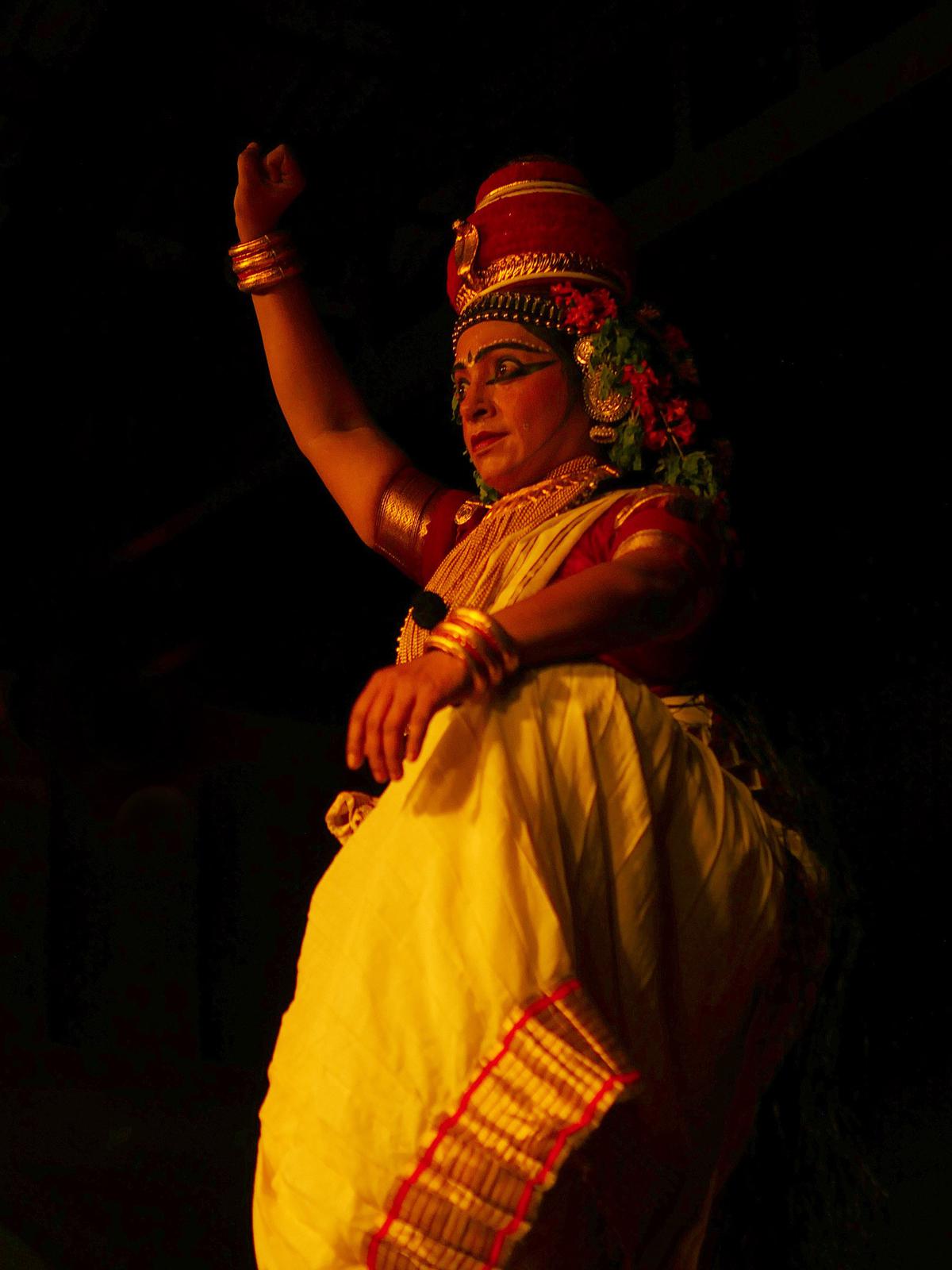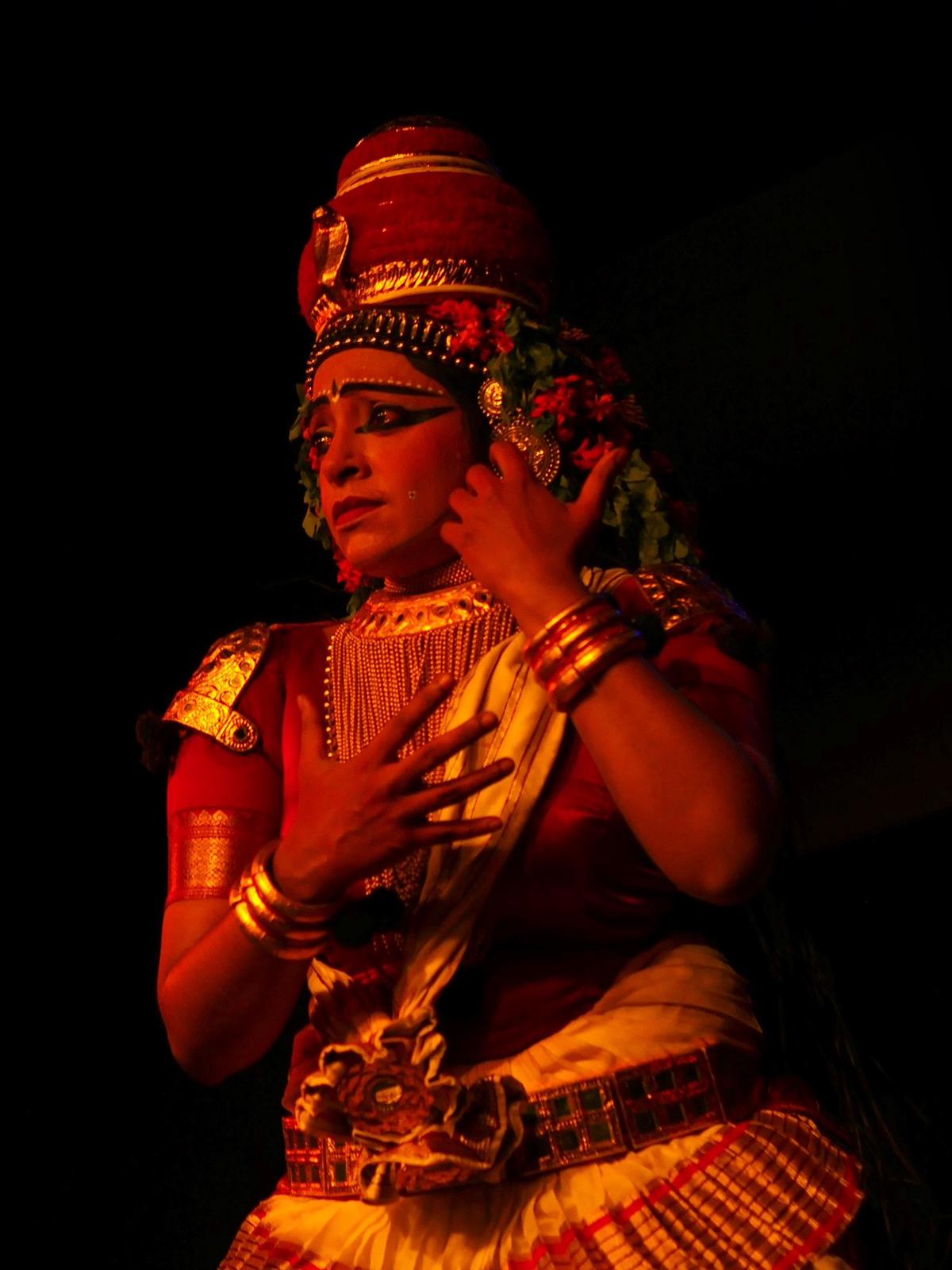
‘Madurai Veeran Kathai’, staged by Kapila Venu at the recently revived Kottichetham auditorium of Natanakairali, in Irinjalakuda.
| Photo Credit: Photo Courtesy: Kapila Venu
Koodiyattam cannot alienate itself from Tamil or Tamizhagam, though it is widely accepted as the Sanskrit theatre tradition that survives only in Kerala. Chakyars, the traditional performers of this art form, are believed to have hailed from Tamil Nadu. Still, stories culled from Tamil have been practically nil in Koodiyattam.
Viewed against this backdrop, Kapila Venu’s latest choreography in Nangiarkoothu (an off-shoot of Koodiyattam performed only by women) – ‘Madurai Veeran Kathai’ – is a path-breaker. The one-and-a-half-hour performance was staged by Kapila at the recently revived Kottichetham auditorium of Natanakairali, in Irinjalakuda.
A warrior turned family deity
Madurai Veeran is a Tamil folk deity popular in Tamil Nadu. His name was derived as a result of his association with Madurai as a protector of the city. He is widely worshipped as a hero of the people. His name literally means ‘warrior of Madurai’. Further, there have been innumerable folk songs, ballads and dramas anchored on him.
Veeran was born into a royal family but was abandoned. Subsequently, he was adopted by a couple from the Arunthathiyar community. Growing up among them, he eventually became a guard in the court of Bommanna Nayakan. His fame brought him to Madurai, where King Thirumalai Nayakar sought his assistance to protect the city from bandits.
During his stay in Madurai, Veeran sees the royal dancer Vellaiyammal and falls for her. Vellaiyammal too gets drawn to him due to his striking appearance and proficiency in various arts.
One fateful night, Veeran gets caught by the guards of nayakar while trying to elope with Vellaiyammal from Madurai.
He is subjected to severe punishment and the guards amputate his limbs Vellaiyammal, who witnesses this, decides to end her life. But prayers are offered to Madurai Meenakshi wishing for Veeran’s recovery. As an answer to the prayers, he gets back his limbs. But eventually Veeran, who believes it is god’s will that he must die, beheads himself. After this, Thirumalai Nayakar builds a temple for Veeran, who is now being worshipped and considered as the family deity of many communities in Tamil Nadu.

Kapila’s histronics and the nuances of Nangiarkoothu was brought to the fore in her depiction of Madurai Veeran.
| Photo Credit:
Photo Courtesy: Kapila Venu
Histrionics skills
Kapila has choreographed her performance with an aim to highlight the major episodes that served to bring out her histrionic skills in full and techniques, unique to Nangiarkoothu. Her netrabhinaya was praiseworthy.
Veeran was accorded a heroic welcome at Madurai which has been bewitchingly choreographed. The celebration was stimulating as she enacted the playing of the typical musical instruments of Tamil Nadu such as the Nagaswaram, thavil, parai and pambai. Together with two mizhavus and edakka drumming varied talas, her performance was exciting, eliciting applause from the audience.
The portrayal of Vellaiyammal, her artistic skills and the garlanding of Veeran were noteworthy. One could appreciate Kapila’s efforts to focus on the subtleties which reflected well in the depiction of the robbery scene.

Kapila Venu’s ‘Madurai Veeran Kathai’ performed for the first time in Nangiarkoothu style.
| Photo Credit:
Photo Courtesy: Kapila Venu
Kapila’s portrayal of Madurai Meenakshi, standing on a pedestal, was awe-inspiring. Coupled with loud prayers by the people to save Veeran, the atmosphere was stirring. Delectable were the charis (gaits) peculiar to Koodiyattam, especially those employed in fight.
Through the usage of the Three couplets from Thirukural, which play a significant role in this thematic production, Tamil has become a part of the repertoire of Nangiarkoothu – an unprecedented gesture.
Kalamandalam Rajeev and Kalamandalam Hariharan played on the mizhavu and Kalanilayam Unnikrishnan on the edakka.